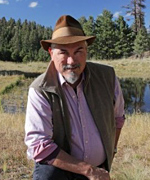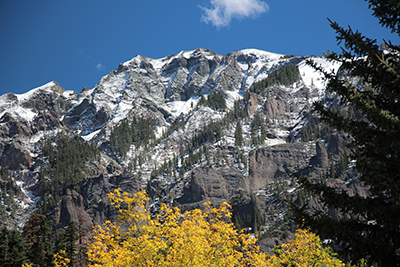—Alan Dulaney
 The colors change differentially in a Southwestern autumn. Aspens turn quickly at altitude, but down in the desert only the colors of the license plates are showing any shift. And in contrast to our tumultuous summer, the controversies of the water world appear to be shifting to a more quiescent mode.
The colors change differentially in a Southwestern autumn. Aspens turn quickly at altitude, but down in the desert only the colors of the license plates are showing any shift. And in contrast to our tumultuous summer, the controversies of the water world appear to be shifting to a more quiescent mode.
Some progress has been made on serious issues. Minute 323 has been signed. This addendum to the treaty between the United States and Mexico concerning shared international streams will run for nine years and replaces Minute 319, due to expire in December. It provides for continued sharing of surpluses and shortages on the Colorado River between the two countries, as well as for continued flows across the border for preservation of cienega environments in the delta. It is a major step forward in achieving consensus on a Drought Contingency Plan for the Lower Basin by committing Mexico to helping maintain water level elevations in Lake Mead above extreme shortage trigger levels. Negotiations were long and hard. ADWR Director Tom Buschatzke was on hand to sign the final agreement for Arizona, with many others.
The Governor’s Water Discussion Group has now gone silent as it chews on the details of concepts proposed and accepted in order to develop legislative proposals for January. Under pressure from the Governor’s Office, it has been a cooperative effort, focused on both Colorado River and groundwater issues. Consensus was not easy. One of the trends faced by the groundwater subgroup was the slow collision of agricultural and urban interests as both expand and use more water in rural counties. Wells are drying up in counties like Cochise, La Paz, and Mohave that previously looked askance at any regulatory solutions such as those embodied in the 1980 Groundwater Management Act. Conflicts are emerging, similar to those that led up to the GWMA. It is possible that innovative approaches will involve expanding existing programs such as the Adequate Water Supply program and well registration and reporting. Clearly, a need exists for more information on the aquifers of rural Arizona—and this will drive demand for more hydrologists.
 Navajo Generating Station will stay operational through 2019, but no new partners have been found to run the plant that would be acceptable to the Navajo Nation. NGS supports a lot of jobs in Page, and it supplies electricity to run the pumps that move CAP water uphill to Tucson. It was only a few years ago that the threat of closure set off alarms amongst water managers across the state, but now that closure by December 22, 2019, is certain (unless a new operator signs on to run the plant), there seems to be little interest, much less panic. The energy markets have evolved rapidly over the last 5 years, and cheap electricity is everywhere.
Navajo Generating Station will stay operational through 2019, but no new partners have been found to run the plant that would be acceptable to the Navajo Nation. NGS supports a lot of jobs in Page, and it supplies electricity to run the pumps that move CAP water uphill to Tucson. It was only a few years ago that the threat of closure set off alarms amongst water managers across the state, but now that closure by December 22, 2019, is certain (unless a new operator signs on to run the plant), there seems to be little interest, much less panic. The energy markets have evolved rapidly over the last 5 years, and cheap electricity is everywhere.
The San Juan Mountains in southwestern Colorado were sporting fresh snowfall last week, when I snapped this photo. An early snowpack could portend more precipitation for the Colorado River Basin, and thus an extra year or two before probabilities for a declared shortage again creep above 30 percent. Perhaps the Salt-Verde system will run full. Maybe the Legislature will pass water bills that are beneficial and far-reaching. Perhaps 2018 will be a good year for water. Hope is an essential characteristic for hydrologists, so let us share it.